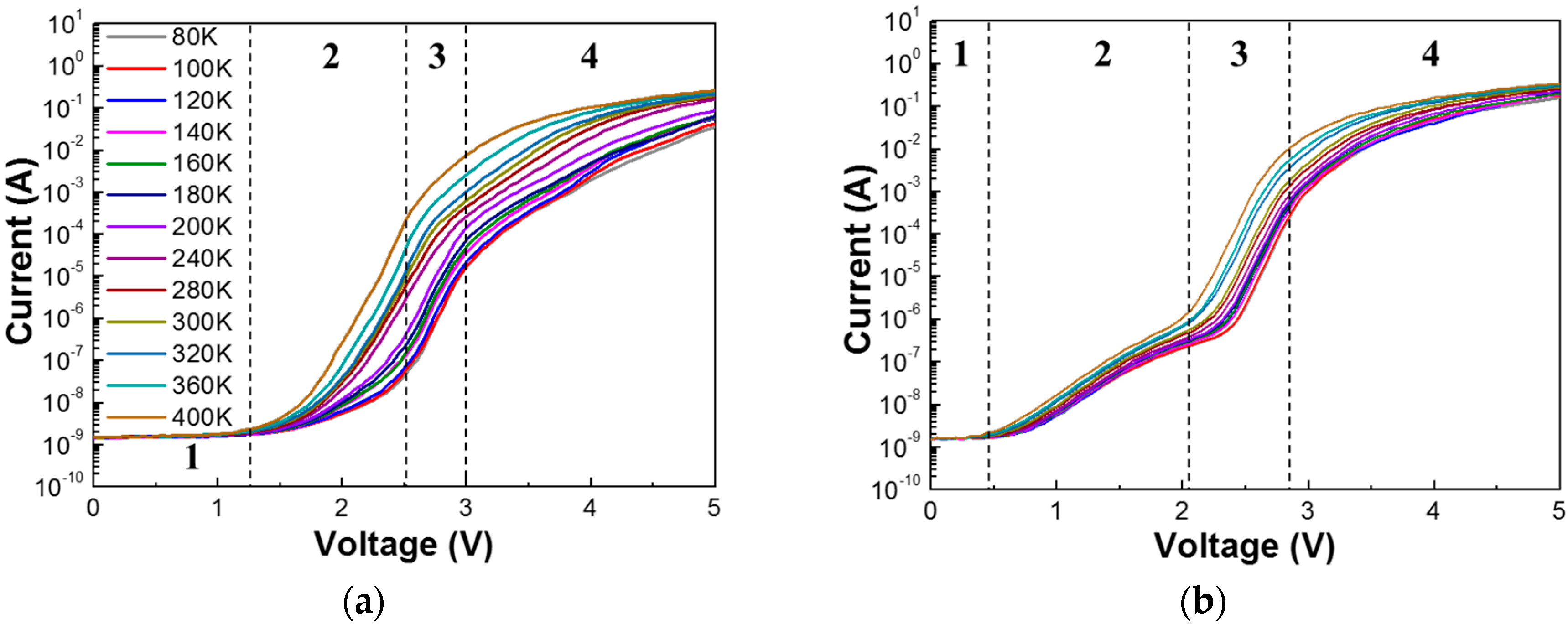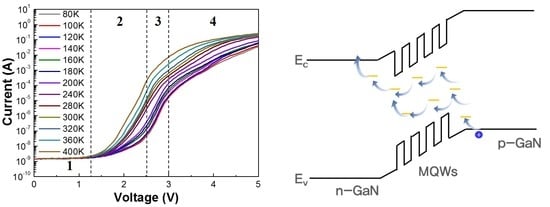Investigation of Forward Tunneling Characteristics of InGaN/GaN Blue Light-Emitting Diodes on Freestanding GaN Detached from a Si Substrate
Abstract
:1. Introduction
2. Materials and Methods
3. Results and Discussion
4. Conclusions
Author Contributions
Funding
Acknowledgments
Conflicts of Interest
References
- Pozina, G.; Ciechonski, R.; Bi, Z.; Samuelson, L.; Monemar, B. Dislocation related droop in InGaN/GaN light emitting diodes investigated via cathodoluminescence. Appl. Phys. Lett. 2015, 107, 251106. [Google Scholar] [CrossRef] [Green Version]
- Zang, Z.; Zeng, X.; Du, J.; Wang, M.; Tang, X. Femtosecond laser direct writing of microholes on roughened ZnO for output power enhancement of InGaN light-emitting diodes. Opt. Lett. 2016, 41, 3463–3466. [Google Scholar] [CrossRef] [PubMed]
- Jeong, H.; Jeong, M.S. Confocal electroluminescence investigations of highly efficient green InGaN LED via ZnO nanorods. J. Alloys Compd. 2016, 660, 480–485. [Google Scholar] [CrossRef]
- Sun, Q.; Yan, W.; Feng, M.; Li, Z.; Feng, B.; Zhao, H.; Yang, H. GaN-on-Si blue/white LEDs: Epitaxy, chip, and package. J. Semicond. 2016, 37, 044006. [Google Scholar] [CrossRef]
- Baek, S.; Kang, G.; Shin, D.; Bae, K.; Kim, Y.H.; Kim, K. Improvement of light extraction efficiency in flip-chip light emitting diodes on SiC substrate via transparent haze films with morphology-controlled collapsed alumina nanorods. ACS Appl. Mater. Interface 2015, 8, 135–141. [Google Scholar] [CrossRef] [PubMed]
- Nakamura, S. Nobel Lecture: Background story of the invention of efficient blue InGaN light emitting diodes. Rev. Mod. Phys. 2015, 87, 1139. [Google Scholar] [CrossRef]
- Lee, M.; Yang, M.; Song, K.M.; Park, S. InGaN/GaN Blue Light Emitting Diodes Using Freestanding GaN Extracted from a Si Substrate. ACS Photonics 2018, 5, 1453–1459. [Google Scholar] [CrossRef]
- Cao, X.; Sandvik, P.; LeBoeuf, S.; Arthur, S. Defect generation in InGaN/GaN light-emitting diodes under forward and reverse electrical stresses. Microelectron. Reliab. 2003, 43, 1987–1991. [Google Scholar] [CrossRef]
- Lee, M.; Mikulik, D.; Park, S. The investigation of in situ removal of Si substrates for freestanding GaN crystals by HVPE. RSC Adv. 2018, 8, 12310–12314. [Google Scholar] [CrossRef] [Green Version]
- Jogai, B.; Wang, K. Dependence of tunneling current on structural variations of superlattice devices. Appl. Phys. Lett. 1985, 46, 167–168. [Google Scholar] [CrossRef]
- Cao, X.; Stokes, E.; Sandvik, P.; LeBoeuf, S.; Kretchmer, J.; Walker, D. Diffusion and tunneling currents in GaN/InGaN multiple quantum well light-emitting diodes. IEEE Electron Device Lett. 2002, 23, 535–537. [Google Scholar] [CrossRef]
- Yan, D.; Lu, H.; Chen, D.; Zhang, R.; Zheng, Y. Forward tunneling current in GaN-based blue light-emitting diodes. Appl. Phys. Lett. 2010, 96, 083504. [Google Scholar] [CrossRef]
- Zhang, J.-Y.; Cai, L.-E.; Zhang, B.-P.; Hu, X.-L.; Jiang, F.; Yu, J.-Z.; Wang, Q.-M. Efficient hole transport in asymmetric coupled InGaN multiple quantum wells. Appl. Phys. Lett. 2009, 95, 161110. [Google Scholar] [CrossRef]
- Perlin, P.; Osiński, M.; Eliseev, P.G.; Smagley, V.A.; Mu, J.; Banas, M.; Sartori, P. Low-temperature study of current and electroluminescence in InGaN/AlGaN/GaN double-heterostructure blue light-emitting diodes. Appl. Phys. Lett. 1996, 69, 1680–1682. [Google Scholar] [CrossRef]
- Sze, S.M.; Ng, K.K. Physics of Semiconductor Devices; John Wiley & Sons: Hoboken, NJ, USA, 2006. [Google Scholar]
- Lee, S.; Oh, D.; Goto, H.; Ha, J.; Lee, H.; Hanada, T.; Cho, M.; Yao, T.; Hong, S.; Lee, H. Origin of forward leakage current in GaN-based light-emitting devices. Appl. Phys. Lett. 2006, 89, 132117. [Google Scholar] [CrossRef]
- Zhi, T.; Tao, T.; Liu, B.; Li, Y.; Zhuang, Z.; Zhang, G.; Xie, Z.; Zhang, R.; Zheng, Y. Asymmetric tunneling model of forward leakage current in GaN/InGaN light emitting diodes. AIP Adv. 2015, 5, 087151. [Google Scholar] [CrossRef] [Green Version]
- Casey, H., Jr.; Muth, J.; Krishnankutty, S.; Zavada, J. Dominance of tunneling current and band filling in InGaN/AlGaN double heterostructure blue light-emitting diodes. Appl. Phys. Lett. 1996, 68, 2867–2869. [Google Scholar] [CrossRef]
- Xu, J.; Schubert, M.F.; Noemaun, A.N.; Zhu, D.; Kim, J.K.; Schubert, E.F.; Kim, M.H.; Chung, H.J.; Yoon, S.; Sone, C. Reduction in efficiency droop, forward voltage, ideality factor, and wavelength shift in polarization-matched GaInN/GaInN multi-quantum-well light-emitting diodes. Appl. Phys. Lett. 2009, 94, 011113. [Google Scholar] [CrossRef] [Green Version]
- Hirsch, L.; Barriere, A.-S. Electrical characterization of InGaN/GaN light emitting diodes grown by molecular beam epitaxy. J. Appl. Phys. 2003, 94, 5014–5020. [Google Scholar] [CrossRef]
- Jian, R.; Li, L.; Yan, D.; Gu, X. Analysis of Forward Tunnelling Current in GaN-based Blue LEDs. In Proceedings of the 2nd International Conference on Computer Science and Electronics Engineering, Los Angeles, CA, USA, 1–2 July 2013; Atlantis Press: Paris, France, 2013. [Google Scholar]
- Reynolds, C., Jr.; Patel, A. Tunneling entity in different injection regimes of InGaN light emitting diodes. J. Appl. Phys. 2008, 103, 086102. [Google Scholar] [CrossRef]
- Kozodoy, P.; DenBaars, S.P.; Mishra, U.K. Depletion region effects in Mg-doped GaN. J. Appl. Phys. 2000, 87, 770–775. [Google Scholar] [CrossRef]
- Kim, J.; Tak, Y.; Kim, J.; Chae, S.; Kim, J.-Y.; Park, Y. Analysis of forward tunneling current in InGaN/GaN multiple quantum well light-emitting diodes grown on Si (111) substrate. J. Appl. Phys. 2013, 114, 013101. [Google Scholar] [CrossRef]
- Cao, X.; Teetsov, J.; D’Evelyn, M.; Merfeld, D.; Yan, C. Electrical characteristics of InGaN/ GaN light-emitting diodes grown on GaN and sapphire substrates. Appl. Phys. Lett. 2004, 85, 7–9. [Google Scholar] [CrossRef]




| Ref. | Substrate | Bias Region | ET (meV) | Dominant Tunneling Entity |
|---|---|---|---|---|
| This study | GaN | II, III | 38.6 | Heavy hole |
| This study | Sapphire | II | 98.4 | Electron |
| III | 38.6 | Heavy hole | ||
| [22] | GaN | 1.8–2.6 | 77 | Heavy hole |
| [22] | Sapphire | 0.3‒1.5 | 184 | Electron |
| 1.9‒2.4 | 77 | Heavy hole | ||
| [24] | Si | 1.2‒1.8 | 128 | Electron |
| 1.6‒2.5 | 56 | Heavy hole |
© 2018 by the authors. Licensee MDPI, Basel, Switzerland. This article is an open access article distributed under the terms and conditions of the Creative Commons Attribution (CC BY) license (http://creativecommons.org/licenses/by/4.0/).
Share and Cite
Lee, M.; Lee, H.; Song, K.M.; Kim, J. Investigation of Forward Tunneling Characteristics of InGaN/GaN Blue Light-Emitting Diodes on Freestanding GaN Detached from a Si Substrate. Nanomaterials 2018, 8, 543. https://doi.org/10.3390/nano8070543
Lee M, Lee H, Song KM, Kim J. Investigation of Forward Tunneling Characteristics of InGaN/GaN Blue Light-Emitting Diodes on Freestanding GaN Detached from a Si Substrate. Nanomaterials. 2018; 8(7):543. https://doi.org/10.3390/nano8070543
Chicago/Turabian StyleLee, Moonsang, Hyunkyu Lee, Keun Man Song, and Jaekyun Kim. 2018. "Investigation of Forward Tunneling Characteristics of InGaN/GaN Blue Light-Emitting Diodes on Freestanding GaN Detached from a Si Substrate" Nanomaterials 8, no. 7: 543. https://doi.org/10.3390/nano8070543
APA StyleLee, M., Lee, H., Song, K. M., & Kim, J. (2018). Investigation of Forward Tunneling Characteristics of InGaN/GaN Blue Light-Emitting Diodes on Freestanding GaN Detached from a Si Substrate. Nanomaterials, 8(7), 543. https://doi.org/10.3390/nano8070543






